Operations Management and Decision-Making Models: A Study on Amazon's Growth and Globalization
VerifiedAdded on 2023/06/10
|11
|3039
|217
AI Summary
This study explores the growth and globalization of Amazon through innovation, diversification, and automation. It also examines the implications of Amazon's increased presence in the Australian retail industry. Can e-commerce ever replace in-person shopping experience? Find out in this study.
Contribute Materials
Your contribution can guide someone’s learning journey. Share your
documents today.
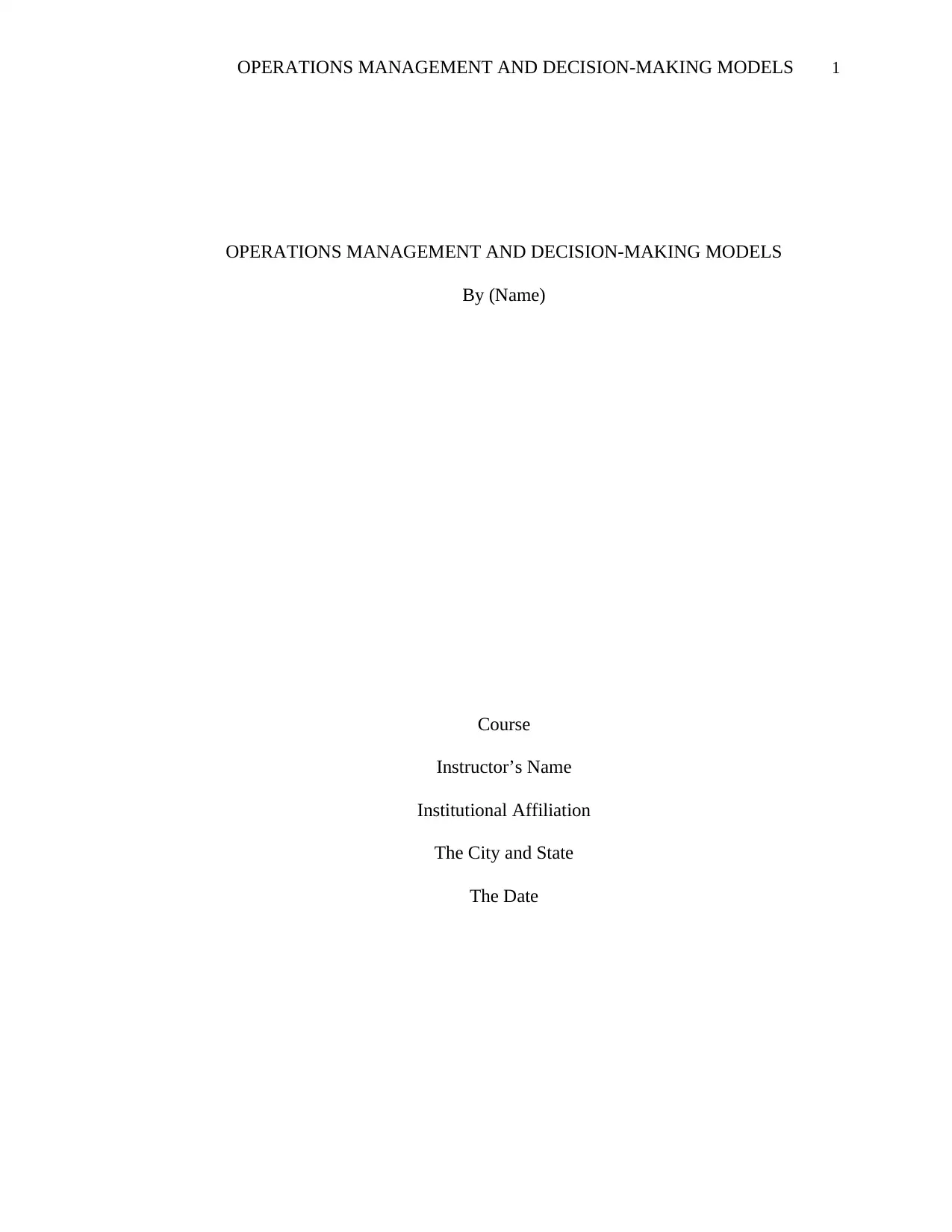
OPERATIONS MANAGEMENT AND DECISION-MAKING MODELS 1
OPERATIONS MANAGEMENT AND DECISION-MAKING MODELS
By (Name)
Course
Instructor’s Name
Institutional Affiliation
The City and State
The Date
OPERATIONS MANAGEMENT AND DECISION-MAKING MODELS
By (Name)
Course
Instructor’s Name
Institutional Affiliation
The City and State
The Date
Secure Best Marks with AI Grader
Need help grading? Try our AI Grader for instant feedback on your assignments.
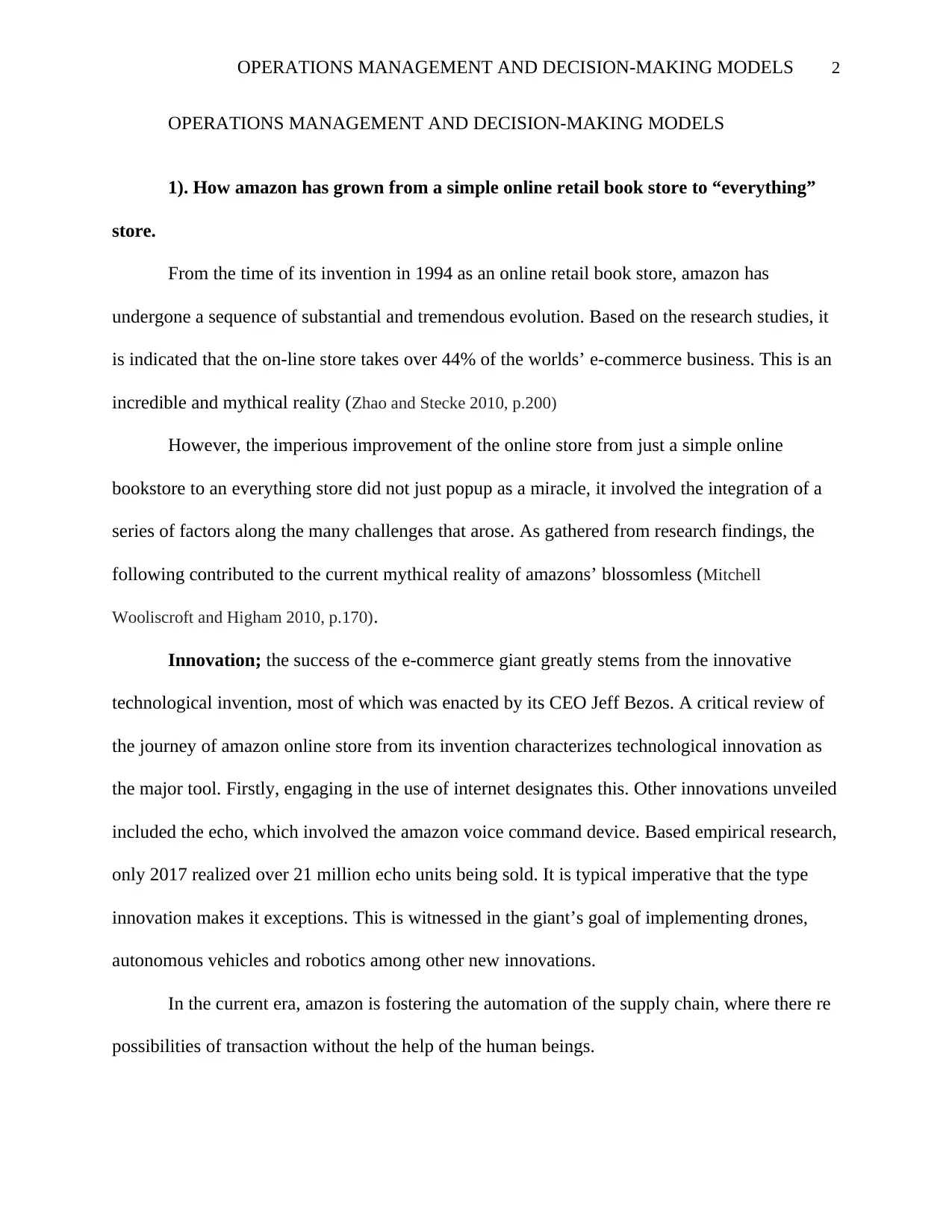
OPERATIONS MANAGEMENT AND DECISION-MAKING MODELS 2
OPERATIONS MANAGEMENT AND DECISION-MAKING MODELS
1). How amazon has grown from a simple online retail book store to “everything”
store.
From the time of its invention in 1994 as an online retail book store, amazon has
undergone a sequence of substantial and tremendous evolution. Based on the research studies, it
is indicated that the on-line store takes over 44% of the worlds’ e-commerce business. This is an
incredible and mythical reality (Zhao and Stecke 2010, p.200)
However, the imperious improvement of the online store from just a simple online
bookstore to an everything store did not just popup as a miracle, it involved the integration of a
series of factors along the many challenges that arose. As gathered from research findings, the
following contributed to the current mythical reality of amazons’ blossomless (Mitchell
Wooliscroft and Higham 2010, p.170).
Innovation; the success of the e-commerce giant greatly stems from the innovative
technological invention, most of which was enacted by its CEO Jeff Bezos. A critical review of
the journey of amazon online store from its invention characterizes technological innovation as
the major tool. Firstly, engaging in the use of internet designates this. Other innovations unveiled
included the echo, which involved the amazon voice command device. Based empirical research,
only 2017 realized over 21 million echo units being sold. It is typical imperative that the type
innovation makes it exceptions. This is witnessed in the giant’s goal of implementing drones,
autonomous vehicles and robotics among other new innovations.
In the current era, amazon is fostering the automation of the supply chain, where there re
possibilities of transaction without the help of the human beings.
OPERATIONS MANAGEMENT AND DECISION-MAKING MODELS
1). How amazon has grown from a simple online retail book store to “everything”
store.
From the time of its invention in 1994 as an online retail book store, amazon has
undergone a sequence of substantial and tremendous evolution. Based on the research studies, it
is indicated that the on-line store takes over 44% of the worlds’ e-commerce business. This is an
incredible and mythical reality (Zhao and Stecke 2010, p.200)
However, the imperious improvement of the online store from just a simple online
bookstore to an everything store did not just popup as a miracle, it involved the integration of a
series of factors along the many challenges that arose. As gathered from research findings, the
following contributed to the current mythical reality of amazons’ blossomless (Mitchell
Wooliscroft and Higham 2010, p.170).
Innovation; the success of the e-commerce giant greatly stems from the innovative
technological invention, most of which was enacted by its CEO Jeff Bezos. A critical review of
the journey of amazon online store from its invention characterizes technological innovation as
the major tool. Firstly, engaging in the use of internet designates this. Other innovations unveiled
included the echo, which involved the amazon voice command device. Based empirical research,
only 2017 realized over 21 million echo units being sold. It is typical imperative that the type
innovation makes it exceptions. This is witnessed in the giant’s goal of implementing drones,
autonomous vehicles and robotics among other new innovations.
In the current era, amazon is fostering the automation of the supply chain, where there re
possibilities of transaction without the help of the human beings.
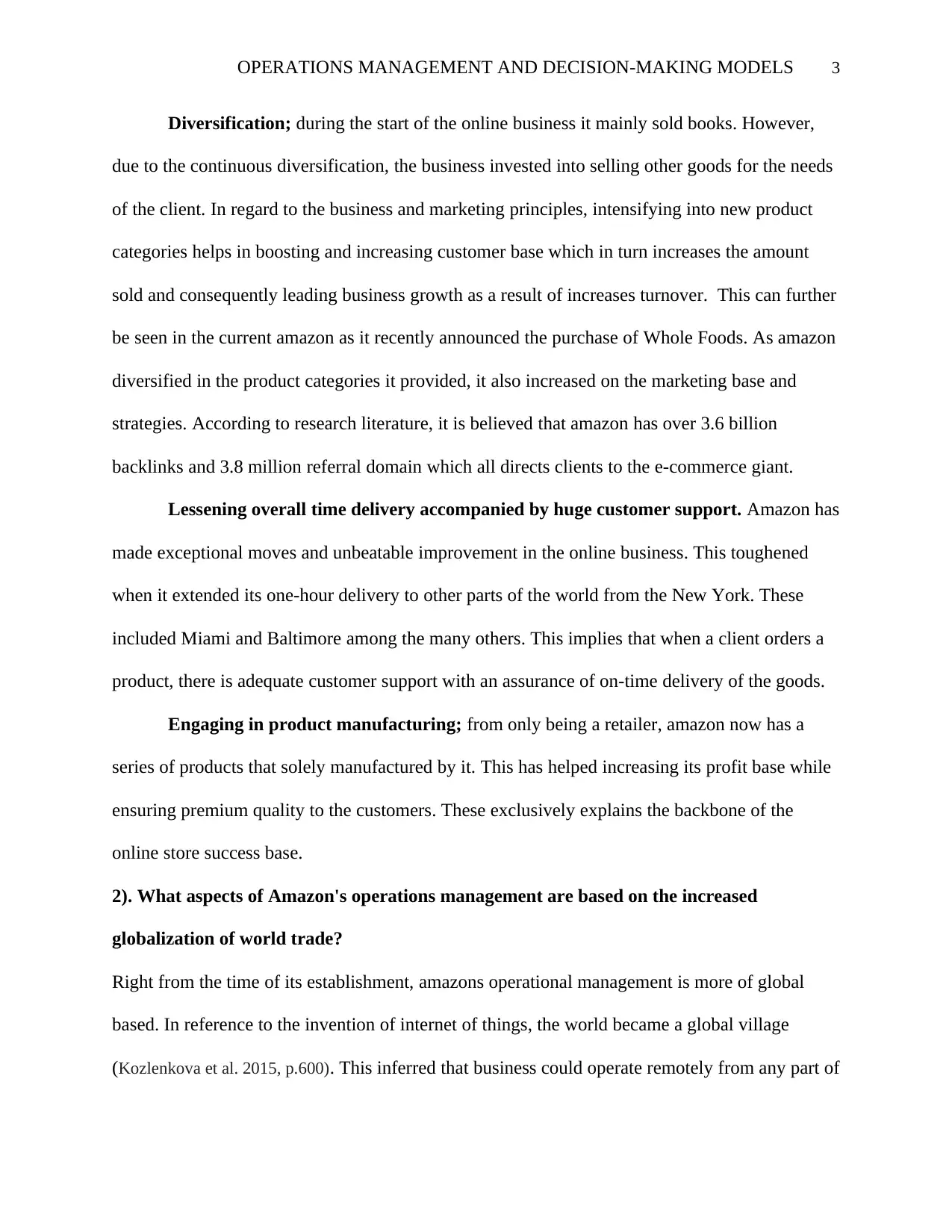
OPERATIONS MANAGEMENT AND DECISION-MAKING MODELS 3
Diversification; during the start of the online business it mainly sold books. However,
due to the continuous diversification, the business invested into selling other goods for the needs
of the client. In regard to the business and marketing principles, intensifying into new product
categories helps in boosting and increasing customer base which in turn increases the amount
sold and consequently leading business growth as a result of increases turnover. This can further
be seen in the current amazon as it recently announced the purchase of Whole Foods. As amazon
diversified in the product categories it provided, it also increased on the marketing base and
strategies. According to research literature, it is believed that amazon has over 3.6 billion
backlinks and 3.8 million referral domain which all directs clients to the e-commerce giant.
Lessening overall time delivery accompanied by huge customer support. Amazon has
made exceptional moves and unbeatable improvement in the online business. This toughened
when it extended its one-hour delivery to other parts of the world from the New York. These
included Miami and Baltimore among the many others. This implies that when a client orders a
product, there is adequate customer support with an assurance of on-time delivery of the goods.
Engaging in product manufacturing; from only being a retailer, amazon now has a
series of products that solely manufactured by it. This has helped increasing its profit base while
ensuring premium quality to the customers. These exclusively explains the backbone of the
online store success base.
2). What aspects of Amazon's operations management are based on the increased
globalization of world trade?
Right from the time of its establishment, amazons operational management is more of global
based. In reference to the invention of internet of things, the world became a global village
(Kozlenkova et al. 2015, p.600). This inferred that business could operate remotely from any part of
Diversification; during the start of the online business it mainly sold books. However,
due to the continuous diversification, the business invested into selling other goods for the needs
of the client. In regard to the business and marketing principles, intensifying into new product
categories helps in boosting and increasing customer base which in turn increases the amount
sold and consequently leading business growth as a result of increases turnover. This can further
be seen in the current amazon as it recently announced the purchase of Whole Foods. As amazon
diversified in the product categories it provided, it also increased on the marketing base and
strategies. According to research literature, it is believed that amazon has over 3.6 billion
backlinks and 3.8 million referral domain which all directs clients to the e-commerce giant.
Lessening overall time delivery accompanied by huge customer support. Amazon has
made exceptional moves and unbeatable improvement in the online business. This toughened
when it extended its one-hour delivery to other parts of the world from the New York. These
included Miami and Baltimore among the many others. This implies that when a client orders a
product, there is adequate customer support with an assurance of on-time delivery of the goods.
Engaging in product manufacturing; from only being a retailer, amazon now has a
series of products that solely manufactured by it. This has helped increasing its profit base while
ensuring premium quality to the customers. These exclusively explains the backbone of the
online store success base.
2). What aspects of Amazon's operations management are based on the increased
globalization of world trade?
Right from the time of its establishment, amazons operational management is more of global
based. In reference to the invention of internet of things, the world became a global village
(Kozlenkova et al. 2015, p.600). This inferred that business could operate remotely from any part of
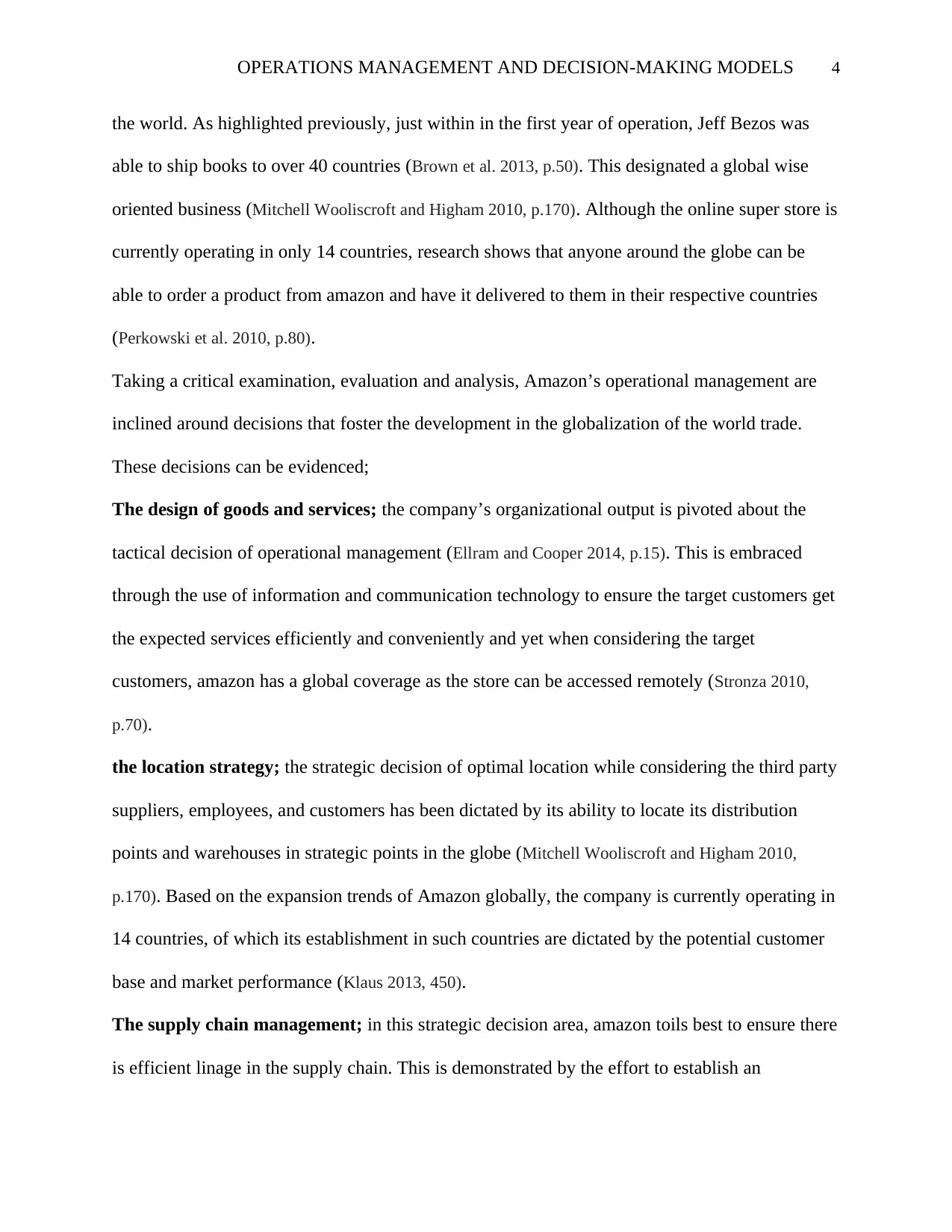
OPERATIONS MANAGEMENT AND DECISION-MAKING MODELS 4
the world. As highlighted previously, just within in the first year of operation, Jeff Bezos was
able to ship books to over 40 countries (Brown et al. 2013, p.50). This designated a global wise
oriented business (Mitchell Wooliscroft and Higham 2010, p.170). Although the online super store is
currently operating in only 14 countries, research shows that anyone around the globe can be
able to order a product from amazon and have it delivered to them in their respective countries
(Perkowski et al. 2010, p.80).
Taking a critical examination, evaluation and analysis, Amazon’s operational management are
inclined around decisions that foster the development in the globalization of the world trade.
These decisions can be evidenced;
The design of goods and services; the company’s organizational output is pivoted about the
tactical decision of operational management (Ellram and Cooper 2014, p.15). This is embraced
through the use of information and communication technology to ensure the target customers get
the expected services efficiently and conveniently and yet when considering the target
customers, amazon has a global coverage as the store can be accessed remotely (Stronza 2010,
p.70).
the location strategy; the strategic decision of optimal location while considering the third party
suppliers, employees, and customers has been dictated by its ability to locate its distribution
points and warehouses in strategic points in the globe (Mitchell Wooliscroft and Higham 2010,
p.170). Based on the expansion trends of Amazon globally, the company is currently operating in
14 countries, of which its establishment in such countries are dictated by the potential customer
base and market performance (Klaus 2013, 450).
The supply chain management; in this strategic decision area, amazon toils best to ensure there
is efficient linage in the supply chain. This is demonstrated by the effort to establish an
the world. As highlighted previously, just within in the first year of operation, Jeff Bezos was
able to ship books to over 40 countries (Brown et al. 2013, p.50). This designated a global wise
oriented business (Mitchell Wooliscroft and Higham 2010, p.170). Although the online super store is
currently operating in only 14 countries, research shows that anyone around the globe can be
able to order a product from amazon and have it delivered to them in their respective countries
(Perkowski et al. 2010, p.80).
Taking a critical examination, evaluation and analysis, Amazon’s operational management are
inclined around decisions that foster the development in the globalization of the world trade.
These decisions can be evidenced;
The design of goods and services; the company’s organizational output is pivoted about the
tactical decision of operational management (Ellram and Cooper 2014, p.15). This is embraced
through the use of information and communication technology to ensure the target customers get
the expected services efficiently and conveniently and yet when considering the target
customers, amazon has a global coverage as the store can be accessed remotely (Stronza 2010,
p.70).
the location strategy; the strategic decision of optimal location while considering the third party
suppliers, employees, and customers has been dictated by its ability to locate its distribution
points and warehouses in strategic points in the globe (Mitchell Wooliscroft and Higham 2010,
p.170). Based on the expansion trends of Amazon globally, the company is currently operating in
14 countries, of which its establishment in such countries are dictated by the potential customer
base and market performance (Klaus 2013, 450).
The supply chain management; in this strategic decision area, amazon toils best to ensure there
is efficient linage in the supply chain. This is demonstrated by the effort to establish an
Secure Best Marks with AI Grader
Need help grading? Try our AI Grader for instant feedback on your assignments.

OPERATIONS MANAGEMENT AND DECISION-MAKING MODELS 5
automated algorithm that can permit transactions without the help of humans. On the other hand,
the company also provides programs and facilities that enhance the growth and development of
third party suppliers which increases the global coverage under one control of amazon store (Lee
and Bradlow 2011, p.890)
Increasing number of warehouses and distribution points; from the time of its introduction,
amazon was able to ship its products to over 40 countries within its first year of business into the
industry. Today, it is reported that the e-commerce business has over thousands of distribution
points and warehouses all over the world yet it further announced a 20 billion investment into the
expansion of distribution points in the emerging markets.
3). Amazon’s marketplace concentrates on smaller sellers and producers by
connecting them with vast customer base and fulfillment programs. Can e-commerce ever
replace the in-person shopping experience?
Looking at the background of the e-commerce business, it is substantially imperative to
say that e-commerce became noticeable to many people only after the invention of the amazon
online book store. In other words, it in typical to say that the pioneer of e-commerce is amazon.
However, the persistent improvement in the level of technology that has led to massive
production of smart phones has taken the e-commerce business to the next level. The
development of software applications for smartphones by specific websites is anchoring the
super growth of the e-commerce business (Shamma and Hassan 2013, p.395).
Never the less, for over decades there has been a continuous and persistent debate of the
online trend visa-vi the in-person shopping experience. Different scholars have invested in the
study of the problem statement (can e-commerce replace the in-person shopping experience) and
have come up with different findings, a little contradictory (Pefanis and Harich 2010, p.340).
automated algorithm that can permit transactions without the help of humans. On the other hand,
the company also provides programs and facilities that enhance the growth and development of
third party suppliers which increases the global coverage under one control of amazon store (Lee
and Bradlow 2011, p.890)
Increasing number of warehouses and distribution points; from the time of its introduction,
amazon was able to ship its products to over 40 countries within its first year of business into the
industry. Today, it is reported that the e-commerce business has over thousands of distribution
points and warehouses all over the world yet it further announced a 20 billion investment into the
expansion of distribution points in the emerging markets.
3). Amazon’s marketplace concentrates on smaller sellers and producers by
connecting them with vast customer base and fulfillment programs. Can e-commerce ever
replace the in-person shopping experience?
Looking at the background of the e-commerce business, it is substantially imperative to
say that e-commerce became noticeable to many people only after the invention of the amazon
online book store. In other words, it in typical to say that the pioneer of e-commerce is amazon.
However, the persistent improvement in the level of technology that has led to massive
production of smart phones has taken the e-commerce business to the next level. The
development of software applications for smartphones by specific websites is anchoring the
super growth of the e-commerce business (Shamma and Hassan 2013, p.395).
Never the less, for over decades there has been a continuous and persistent debate of the
online trend visa-vi the in-person shopping experience. Different scholars have invested in the
study of the problem statement (can e-commerce replace the in-person shopping experience) and
have come up with different findings, a little contradictory (Pefanis and Harich 2010, p.340).

OPERATIONS MANAGEMENT AND DECISION-MAKING MODELS 6
Based on the trend of growth and adaptation of internet of things (IoT), some scholars
had their conclusion that there will come a time when e-commerce will exclusively replace the
in-person store shopping. According to research studies, over a billion people are currently doing
transactions online, which include online shopping and retailing and yet it is just about two
decades since the online business began. With this forecast, it is ample to say that with years to
come, all businesses will be operating remotely just as others are doing (Hu Milner and Wu 2015,
p.870). One of the biggest companies today in the world are online based firms among which
include amazon as one of the main payer, PayPal, Facebook, among many others. The e-
commerce business is further backed up by some extra ordinary and exceptional features it
provides to its users. Some of which include;
The wide market place; with the help of e-commerce, a customer is able to explore a
series of markets, comparing the qualities, quantities, and prices of a particular product while
using different market reviews. This facilitates the value for money as the customer is able to
buy from the lowest prices and of high quality. This further implies that the method is also cost
effective due to the fact that a client can land best prices on the market (Vendrell et al. 2017, p.70).
On the other hand however, some scholars insist that the e-commerce cannot at any point
replace the brick and motor shopping method. The argument is based on the fact that there are a
lot of ongoing scams over the internet. If someone is scammed today, he will definitely prefer the
brick and motor. The primitive shopping, method also allows the ability to try on and try out
products, a feature that cannot be offered by the ecommerce business and finally, the brick and
mortar shopping still occupies over 60% of the shopping popularity.
Based on the trend of growth and adaptation of internet of things (IoT), some scholars
had their conclusion that there will come a time when e-commerce will exclusively replace the
in-person store shopping. According to research studies, over a billion people are currently doing
transactions online, which include online shopping and retailing and yet it is just about two
decades since the online business began. With this forecast, it is ample to say that with years to
come, all businesses will be operating remotely just as others are doing (Hu Milner and Wu 2015,
p.870). One of the biggest companies today in the world are online based firms among which
include amazon as one of the main payer, PayPal, Facebook, among many others. The e-
commerce business is further backed up by some extra ordinary and exceptional features it
provides to its users. Some of which include;
The wide market place; with the help of e-commerce, a customer is able to explore a
series of markets, comparing the qualities, quantities, and prices of a particular product while
using different market reviews. This facilitates the value for money as the customer is able to
buy from the lowest prices and of high quality. This further implies that the method is also cost
effective due to the fact that a client can land best prices on the market (Vendrell et al. 2017, p.70).
On the other hand however, some scholars insist that the e-commerce cannot at any point
replace the brick and motor shopping method. The argument is based on the fact that there are a
lot of ongoing scams over the internet. If someone is scammed today, he will definitely prefer the
brick and motor. The primitive shopping, method also allows the ability to try on and try out
products, a feature that cannot be offered by the ecommerce business and finally, the brick and
mortar shopping still occupies over 60% of the shopping popularity.
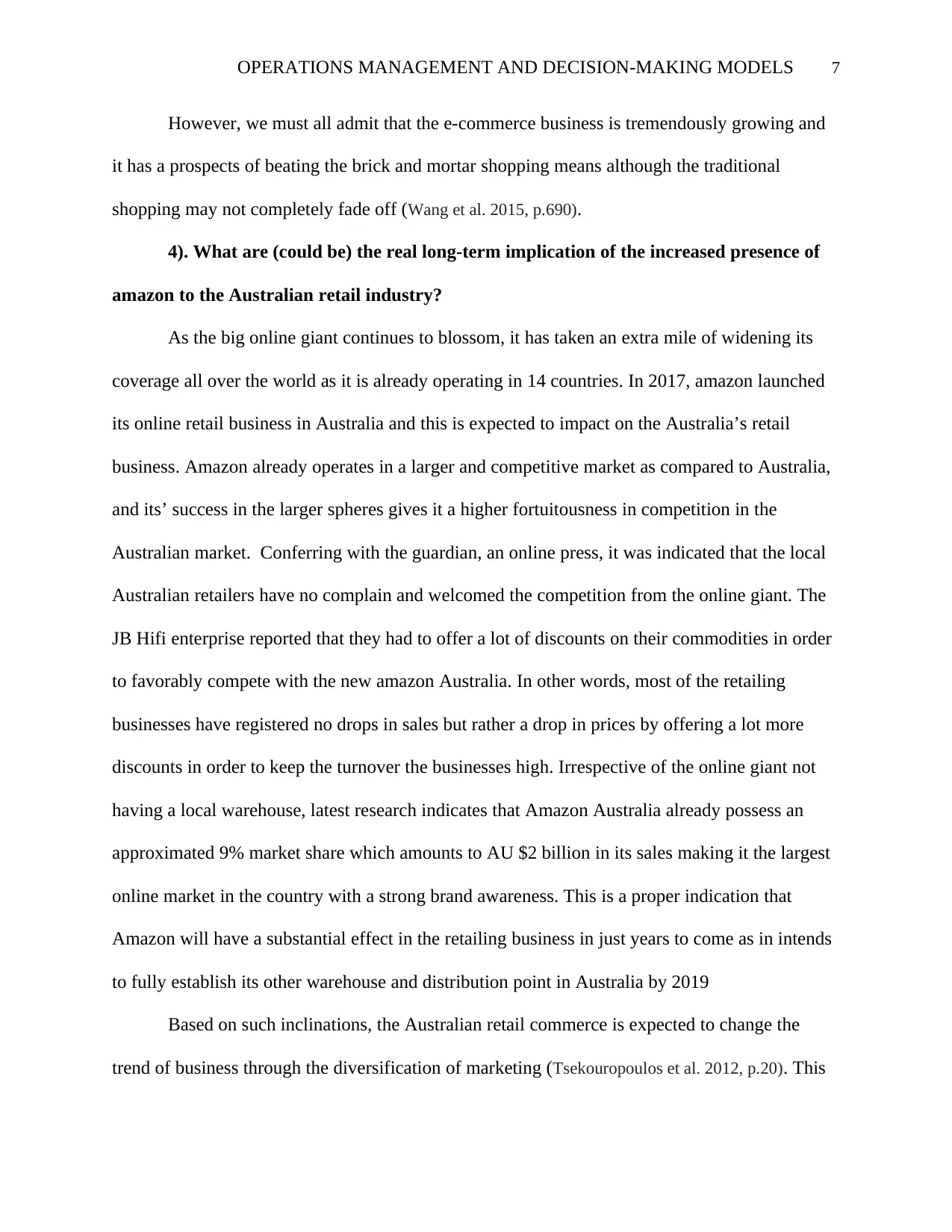
OPERATIONS MANAGEMENT AND DECISION-MAKING MODELS 7
However, we must all admit that the e-commerce business is tremendously growing and
it has a prospects of beating the brick and mortar shopping means although the traditional
shopping may not completely fade off (Wang et al. 2015, p.690).
4). What are (could be) the real long-term implication of the increased presence of
amazon to the Australian retail industry?
As the big online giant continues to blossom, it has taken an extra mile of widening its
coverage all over the world as it is already operating in 14 countries. In 2017, amazon launched
its online retail business in Australia and this is expected to impact on the Australia’s retail
business. Amazon already operates in a larger and competitive market as compared to Australia,
and its’ success in the larger spheres gives it a higher fortuitousness in competition in the
Australian market. Conferring with the guardian, an online press, it was indicated that the local
Australian retailers have no complain and welcomed the competition from the online giant. The
JB Hifi enterprise reported that they had to offer a lot of discounts on their commodities in order
to favorably compete with the new amazon Australia. In other words, most of the retailing
businesses have registered no drops in sales but rather a drop in prices by offering a lot more
discounts in order to keep the turnover the businesses high. Irrespective of the online giant not
having a local warehouse, latest research indicates that Amazon Australia already possess an
approximated 9% market share which amounts to AU $2 billion in its sales making it the largest
online market in the country with a strong brand awareness. This is a proper indication that
Amazon will have a substantial effect in the retailing business in just years to come as in intends
to fully establish its other warehouse and distribution point in Australia by 2019
Based on such inclinations, the Australian retail commerce is expected to change the
trend of business through the diversification of marketing (Tsekouropoulos et al. 2012, p.20). This
However, we must all admit that the e-commerce business is tremendously growing and
it has a prospects of beating the brick and mortar shopping means although the traditional
shopping may not completely fade off (Wang et al. 2015, p.690).
4). What are (could be) the real long-term implication of the increased presence of
amazon to the Australian retail industry?
As the big online giant continues to blossom, it has taken an extra mile of widening its
coverage all over the world as it is already operating in 14 countries. In 2017, amazon launched
its online retail business in Australia and this is expected to impact on the Australia’s retail
business. Amazon already operates in a larger and competitive market as compared to Australia,
and its’ success in the larger spheres gives it a higher fortuitousness in competition in the
Australian market. Conferring with the guardian, an online press, it was indicated that the local
Australian retailers have no complain and welcomed the competition from the online giant. The
JB Hifi enterprise reported that they had to offer a lot of discounts on their commodities in order
to favorably compete with the new amazon Australia. In other words, most of the retailing
businesses have registered no drops in sales but rather a drop in prices by offering a lot more
discounts in order to keep the turnover the businesses high. Irrespective of the online giant not
having a local warehouse, latest research indicates that Amazon Australia already possess an
approximated 9% market share which amounts to AU $2 billion in its sales making it the largest
online market in the country with a strong brand awareness. This is a proper indication that
Amazon will have a substantial effect in the retailing business in just years to come as in intends
to fully establish its other warehouse and distribution point in Australia by 2019
Based on such inclinations, the Australian retail commerce is expected to change the
trend of business through the diversification of marketing (Tsekouropoulos et al. 2012, p.20). This
Paraphrase This Document
Need a fresh take? Get an instant paraphrase of this document with our AI Paraphraser
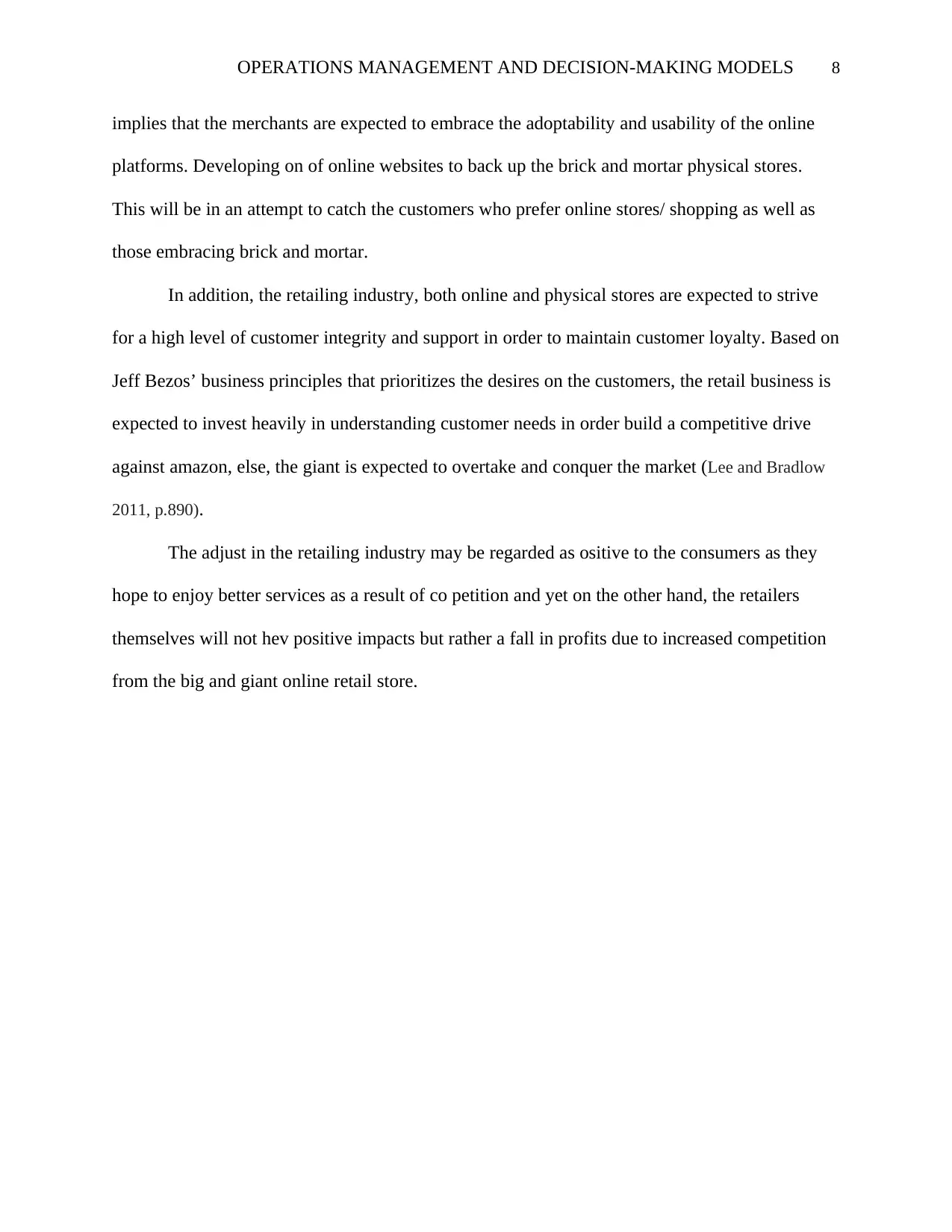
OPERATIONS MANAGEMENT AND DECISION-MAKING MODELS 8
implies that the merchants are expected to embrace the adoptability and usability of the online
platforms. Developing on of online websites to back up the brick and mortar physical stores.
This will be in an attempt to catch the customers who prefer online stores/ shopping as well as
those embracing brick and mortar.
In addition, the retailing industry, both online and physical stores are expected to strive
for a high level of customer integrity and support in order to maintain customer loyalty. Based on
Jeff Bezos’ business principles that prioritizes the desires on the customers, the retail business is
expected to invest heavily in understanding customer needs in order build a competitive drive
against amazon, else, the giant is expected to overtake and conquer the market (Lee and Bradlow
2011, p.890).
The adjust in the retailing industry may be regarded as ositive to the consumers as they
hope to enjoy better services as a result of co petition and yet on the other hand, the retailers
themselves will not hev positive impacts but rather a fall in profits due to increased competition
from the big and giant online retail store.
implies that the merchants are expected to embrace the adoptability and usability of the online
platforms. Developing on of online websites to back up the brick and mortar physical stores.
This will be in an attempt to catch the customers who prefer online stores/ shopping as well as
those embracing brick and mortar.
In addition, the retailing industry, both online and physical stores are expected to strive
for a high level of customer integrity and support in order to maintain customer loyalty. Based on
Jeff Bezos’ business principles that prioritizes the desires on the customers, the retail business is
expected to invest heavily in understanding customer needs in order build a competitive drive
against amazon, else, the giant is expected to overtake and conquer the market (Lee and Bradlow
2011, p.890).
The adjust in the retailing industry may be regarded as ositive to the consumers as they
hope to enjoy better services as a result of co petition and yet on the other hand, the retailers
themselves will not hev positive impacts but rather a fall in profits due to increased competition
from the big and giant online retail store.
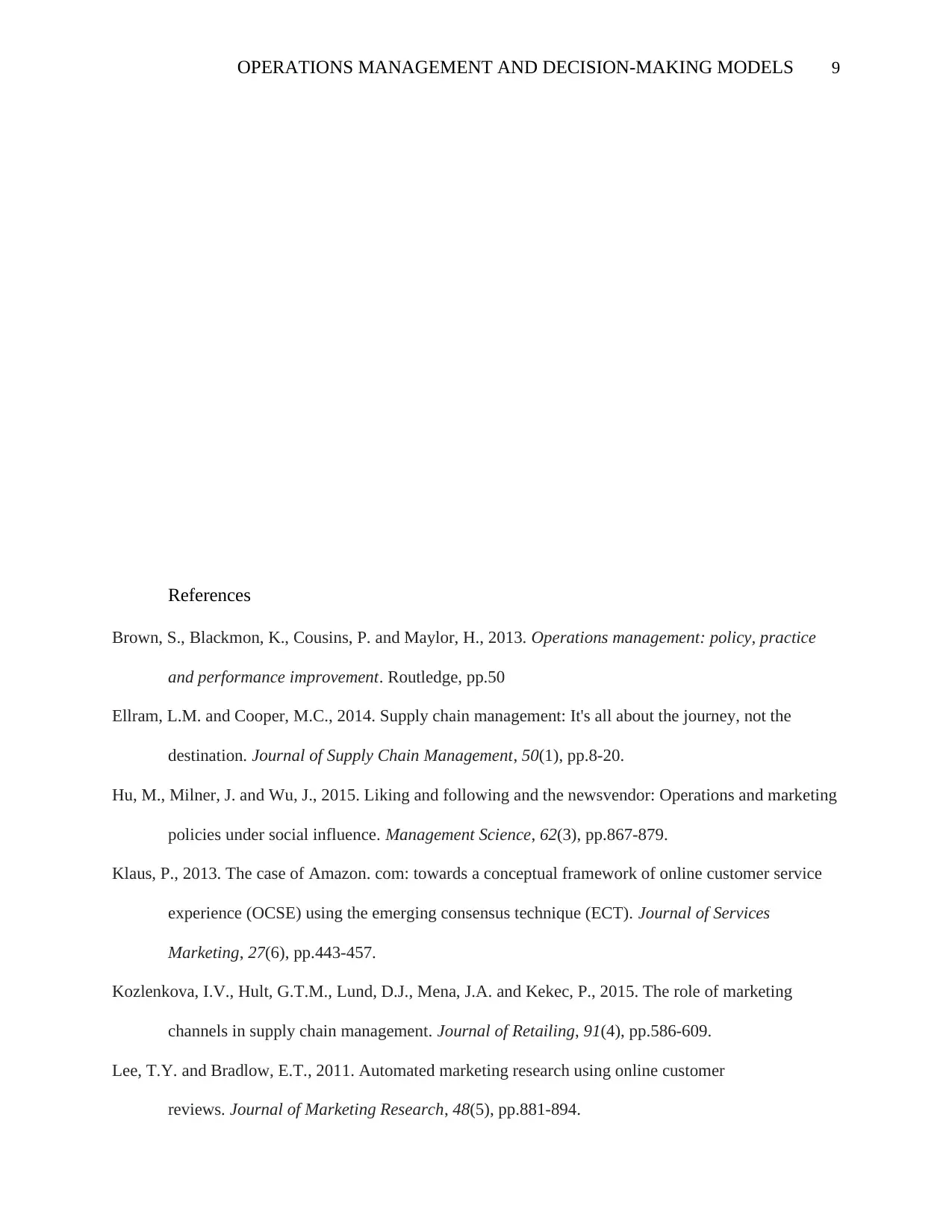
OPERATIONS MANAGEMENT AND DECISION-MAKING MODELS 9
References
Brown, S., Blackmon, K., Cousins, P. and Maylor, H., 2013. Operations management: policy, practice
and performance improvement. Routledge, pp.50
Ellram, L.M. and Cooper, M.C., 2014. Supply chain management: It's all about the journey, not the
destination. Journal of Supply Chain Management, 50(1), pp.8-20.
Hu, M., Milner, J. and Wu, J., 2015. Liking and following and the newsvendor: Operations and marketing
policies under social influence. Management Science, 62(3), pp.867-879.
Klaus, P., 2013. The case of Amazon. com: towards a conceptual framework of online customer service
experience (OCSE) using the emerging consensus technique (ECT). Journal of Services
Marketing, 27(6), pp.443-457.
Kozlenkova, I.V., Hult, G.T.M., Lund, D.J., Mena, J.A. and Kekec, P., 2015. The role of marketing
channels in supply chain management. Journal of Retailing, 91(4), pp.586-609.
Lee, T.Y. and Bradlow, E.T., 2011. Automated marketing research using online customer
reviews. Journal of Marketing Research, 48(5), pp.881-894.
References
Brown, S., Blackmon, K., Cousins, P. and Maylor, H., 2013. Operations management: policy, practice
and performance improvement. Routledge, pp.50
Ellram, L.M. and Cooper, M.C., 2014. Supply chain management: It's all about the journey, not the
destination. Journal of Supply Chain Management, 50(1), pp.8-20.
Hu, M., Milner, J. and Wu, J., 2015. Liking and following and the newsvendor: Operations and marketing
policies under social influence. Management Science, 62(3), pp.867-879.
Klaus, P., 2013. The case of Amazon. com: towards a conceptual framework of online customer service
experience (OCSE) using the emerging consensus technique (ECT). Journal of Services
Marketing, 27(6), pp.443-457.
Kozlenkova, I.V., Hult, G.T.M., Lund, D.J., Mena, J.A. and Kekec, P., 2015. The role of marketing
channels in supply chain management. Journal of Retailing, 91(4), pp.586-609.
Lee, T.Y. and Bradlow, E.T., 2011. Automated marketing research using online customer
reviews. Journal of Marketing Research, 48(5), pp.881-894.
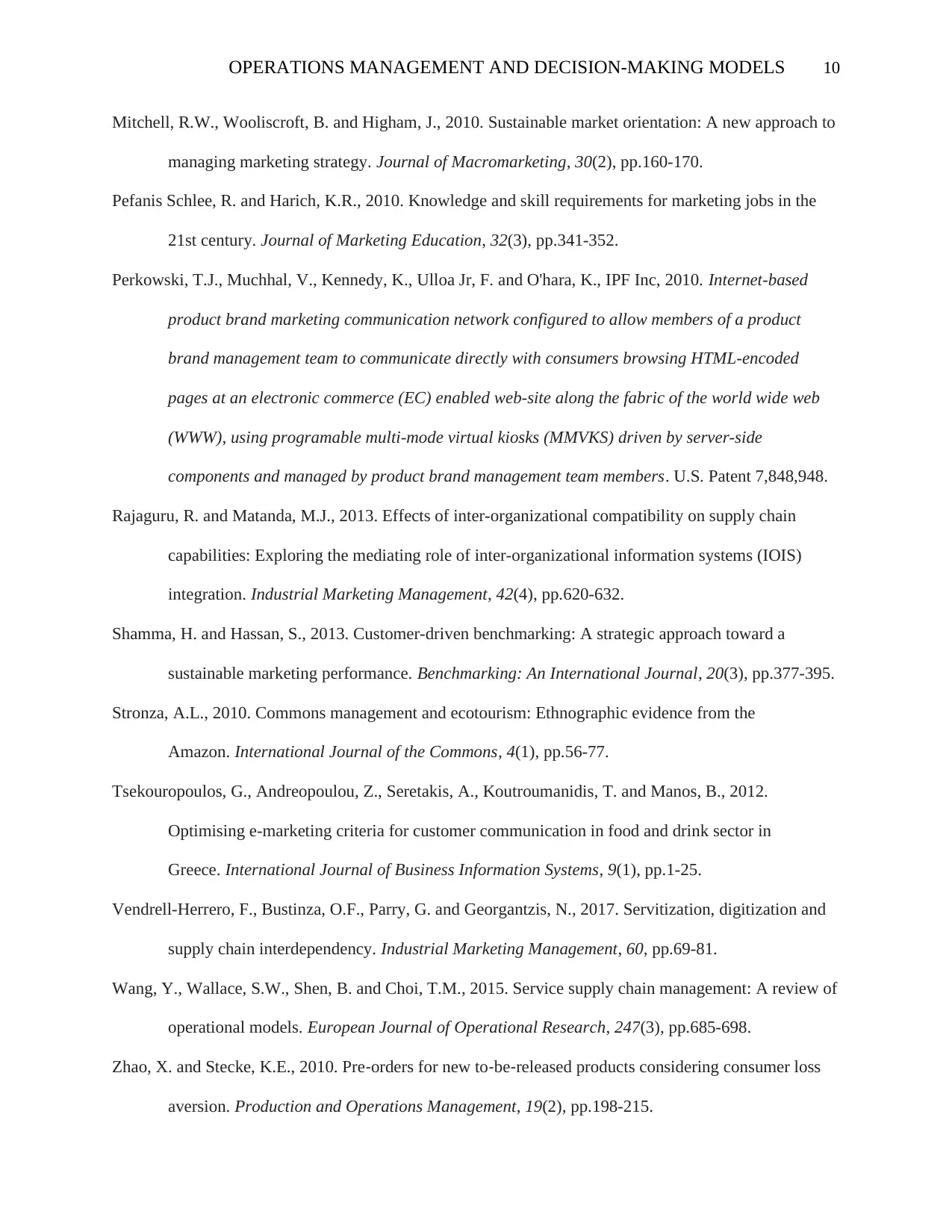
OPERATIONS MANAGEMENT AND DECISION-MAKING MODELS 10
Mitchell, R.W., Wooliscroft, B. and Higham, J., 2010. Sustainable market orientation: A new approach to
managing marketing strategy. Journal of Macromarketing, 30(2), pp.160-170.
Pefanis Schlee, R. and Harich, K.R., 2010. Knowledge and skill requirements for marketing jobs in the
21st century. Journal of Marketing Education, 32(3), pp.341-352.
Perkowski, T.J., Muchhal, V., Kennedy, K., Ulloa Jr, F. and O'hara, K., IPF Inc, 2010. Internet-based
product brand marketing communication network configured to allow members of a product
brand management team to communicate directly with consumers browsing HTML-encoded
pages at an electronic commerce (EC) enabled web-site along the fabric of the world wide web
(WWW), using programable multi-mode virtual kiosks (MMVKS) driven by server-side
components and managed by product brand management team members. U.S. Patent 7,848,948.
Rajaguru, R. and Matanda, M.J., 2013. Effects of inter-organizational compatibility on supply chain
capabilities: Exploring the mediating role of inter-organizational information systems (IOIS)
integration. Industrial Marketing Management, 42(4), pp.620-632.
Shamma, H. and Hassan, S., 2013. Customer-driven benchmarking: A strategic approach toward a
sustainable marketing performance. Benchmarking: An International Journal, 20(3), pp.377-395.
Stronza, A.L., 2010. Commons management and ecotourism: Ethnographic evidence from the
Amazon. International Journal of the Commons, 4(1), pp.56-77.
Tsekouropoulos, G., Andreopoulou, Z., Seretakis, A., Koutroumanidis, T. and Manos, B., 2012.
Optimising e-marketing criteria for customer communication in food and drink sector in
Greece. International Journal of Business Information Systems, 9(1), pp.1-25.
Vendrell-Herrero, F., Bustinza, O.F., Parry, G. and Georgantzis, N., 2017. Servitization, digitization and
supply chain interdependency. Industrial Marketing Management, 60, pp.69-81.
Wang, Y., Wallace, S.W., Shen, B. and Choi, T.M., 2015. Service supply chain management: A review of
operational models. European Journal of Operational Research, 247(3), pp.685-698.
Zhao, X. and Stecke, K.E., 2010. Pre‐orders for new to‐be‐released products considering consumer loss
aversion. Production and Operations Management, 19(2), pp.198-215.
Mitchell, R.W., Wooliscroft, B. and Higham, J., 2010. Sustainable market orientation: A new approach to
managing marketing strategy. Journal of Macromarketing, 30(2), pp.160-170.
Pefanis Schlee, R. and Harich, K.R., 2010. Knowledge and skill requirements for marketing jobs in the
21st century. Journal of Marketing Education, 32(3), pp.341-352.
Perkowski, T.J., Muchhal, V., Kennedy, K., Ulloa Jr, F. and O'hara, K., IPF Inc, 2010. Internet-based
product brand marketing communication network configured to allow members of a product
brand management team to communicate directly with consumers browsing HTML-encoded
pages at an electronic commerce (EC) enabled web-site along the fabric of the world wide web
(WWW), using programable multi-mode virtual kiosks (MMVKS) driven by server-side
components and managed by product brand management team members. U.S. Patent 7,848,948.
Rajaguru, R. and Matanda, M.J., 2013. Effects of inter-organizational compatibility on supply chain
capabilities: Exploring the mediating role of inter-organizational information systems (IOIS)
integration. Industrial Marketing Management, 42(4), pp.620-632.
Shamma, H. and Hassan, S., 2013. Customer-driven benchmarking: A strategic approach toward a
sustainable marketing performance. Benchmarking: An International Journal, 20(3), pp.377-395.
Stronza, A.L., 2010. Commons management and ecotourism: Ethnographic evidence from the
Amazon. International Journal of the Commons, 4(1), pp.56-77.
Tsekouropoulos, G., Andreopoulou, Z., Seretakis, A., Koutroumanidis, T. and Manos, B., 2012.
Optimising e-marketing criteria for customer communication in food and drink sector in
Greece. International Journal of Business Information Systems, 9(1), pp.1-25.
Vendrell-Herrero, F., Bustinza, O.F., Parry, G. and Georgantzis, N., 2017. Servitization, digitization and
supply chain interdependency. Industrial Marketing Management, 60, pp.69-81.
Wang, Y., Wallace, S.W., Shen, B. and Choi, T.M., 2015. Service supply chain management: A review of
operational models. European Journal of Operational Research, 247(3), pp.685-698.
Zhao, X. and Stecke, K.E., 2010. Pre‐orders for new to‐be‐released products considering consumer loss
aversion. Production and Operations Management, 19(2), pp.198-215.
Secure Best Marks with AI Grader
Need help grading? Try our AI Grader for instant feedback on your assignments.

OPERATIONS MANAGEMENT AND DECISION-MAKING MODELS 11
1 out of 11
Related Documents
Your All-in-One AI-Powered Toolkit for Academic Success.
+13062052269
info@desklib.com
Available 24*7 on WhatsApp / Email
![[object Object]](/_next/static/media/star-bottom.7253800d.svg)
Unlock your academic potential
© 2024 | Zucol Services PVT LTD | All rights reserved.




